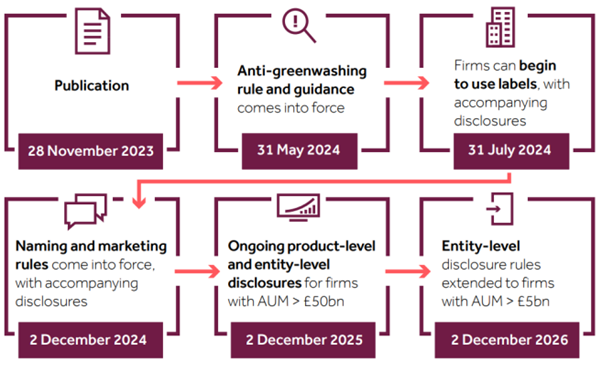Key Insights:
|
|
|
In recent years, there has been a significant push toward greater corporate transparency and accountability regarding sustainability practices. The U.K.’s Sustainability Disclosure Requirements (SDR) stands as a pivotal piece of legislation aimed at fostering environmental, social, and governance (ESG) considerations within the financial sector. To shed light on this important regulation, Kerstin Olausson, Associate Director, Client Relations conducted a Q&A with insights from Morningstar Sustainalytics’ policy expert, Arthur Carabia. Read on for their correspondence on this important topic below.
Kerstin Olausson: Let's start with the basics. What are the U.K. Sustainability Disclosure Requirements?
Arthur Carabia: On Nov. 28, 2023, after two years of extensive consultation, the U.K.'s Financial Conduct Authority (FCA) published the Sustainability Disclosure Requirements and investment labels policy statement. The policy statement contains a substantial package of measures aimed at improving the trust in, and transparency of, sustainable investment products and at minimizing greenwashing. The policy includes the following details:
- An anti-greenwashing rule to ensure claims are fair, clear, and not misleading.
- Four sustainability labels to help consumers navigate the product landscape and enhance trust.
- Naming and marketing rules to ensure the use of sustainability terms is accurate.
- Rules for consumer-facing information to make it easy to understand the sustainability features of investment funds.
- Rules for detailed product information to support investors seeking more granular information.
- Entity-level information to understand asset manager’s sustainability approaches.
- Requirements for distributors to ensure product information is available to consumers.
KO: Can you elaborate on the label regime and principles underlying the U.K. SDR?
AC: The SDR creates four labels for investment products which are voluntary and non-hierarchical, which I've organized as a table here.
Table 1. Summary of SDR Labels and Objectives
| Label | Objective |
| Sustainability Focus | Invests mainly in assets that focus on sustainability for people or the planet. |
| Sustainability Improvers | Invests mainly in assets that may not be sustainable now, with an aim to improve sustainability for people or the planet over time. |
| Sustainability Impact | Invests mainly in solutions to sustainability problems, with an aim to achieve positive impact for people or the planet. |
| Sustainability Mixed Goals | Invests mainly in a mix of assets that either focus on sustainability problems, aim to improve their sustainability over time, or aim to achieve positive impact for people or the planet. |
Source: Policy Statement PS23/16 - Sustainability Disclosure Requirements (SDR) and investment labels. For informational purposes only.
If a firm chooses to label an investment product, it must ensure that the classification and label are appropriate. The FCA will review new funds submitted for authorization and amendments to existing funds. The review does not constitute an approval of the label, and the FCA may challenge the applications.
Common features of the labels are that they all require at least 70% of assets to be invested in accordance with the sustainability objective of the label and follow “a robust, evidence-based standard that is an absolute measure of environmental and/or social sustainability.”1 Examples of such measures include revenue/capex versus environmental/social matters, or EU Taxonomy-based, greenhouse gas (GHG) emissions.
KO: Who does the U.K. SDR apply to?
AC: The labels, naming and marketing rules, and consumer-facing information rules will apply to sustainable funds domiciled in the U.K. The SDR may be expanded later to include pension products, portfolio management, and insurance-based investment products. Funds based outside of the U.K. are not in scope for the moment.2
Distributors of investment products in the U.K., such as financial advisers and platforms, will have targeted rules to ensure that labels and consumer-facing disclosures are made available to retail investors.
The anti-greenwashing rule will apply to all FCA-authorized firms who make sustainability-related claims about products and services.
KO: How will these new reporting and disclosure rules impact investors?
AC: The SDR is important because it will affect how sustainable funds are built and how they are sold to investors. With the implementation of the SDR’s consumer-facing disclosures, investors should hopefully be able to make more informed decisions about their sustainable investing options. Figure 1 shows a recent breakdown of U.K. funds with sustainability-related terms in their names.
Figure 1. Count of U.K. Funds With Sustainability-Related Terms in Names Only

Source: Morningstar Research. Morningstar Direct. For informational purposes only.
Note: Data as of November 2023. Funds with key terms are counted only once. For example, funds with both “Sustainable” and “Responsible” in their names are included only in the “Sustainable/Sustainability” group and funds with “Climate Transition” in their names are included only in the “Climate” group.
The requirement to provide product-level disclosures means asset managers will soon have to review their product ranges to consider which funds should be labeled and which ones can be amended to qualify for a label.3 Figure 2 shows the expected mix of labeled funds by the end of 2024.
Figure 2. Expected Representation of U.K. Labeled Funds by End of 2024

Source: Morningstar Research. Morningstar Direct. For informational purposes only.
Asset managers will also need to upgrade their entity reporting and disclose on sustainability risks and management beyond climate. They can do this by leveraging corporate sustainability disclosure standards set out by the International Sustainability Standard Board (IFRS S1) and the Sustainability Accounting Standards Board (SASB). They will need to make sure that their stewardship strategy (e.g., engagement with companies, exercising of voting rights, monitoring of proxy advisors, etc.) is compatible with their sustainability product offerings and sustainability objectives.
Funds that claim sustainability characteristics won't be forced to opt for a label. However, if they don't use a label, they will have to explain why. Additionally, they will be required to provide the same sustainability disclosures as labeled funds and will not be able to use the terms "sustainable," "sustainability" and "impact" in their product names or communications.
KO: When does the U.K. SDR come into effect?
AC: As shown in the timeline below (Figure 3), the anti-greenwashing rule will come into force from May 31, 2024,3 but the final version has yet to be published. Asset managers will be permitted to use the labels starting July 31, 2024. They will need to ensure that all their naming and marketing is updated by Dec. 2, 2024.
Figure 3. Timeline for Implementation of SDR

Source: SDR Policy Statement. For informational purposes only.
KO: How does the U.K. SDR compare to other sustainability reporting regimes?
AC: While the SDR has a similar objective to the European Union’s Sustainable Finance Disclosure Regulation (SFDR), which is to mitigate risks of greenwashing and protect retail investors, there are significant differences between the regulations. The SDR is overall less data prescriptive but is more comprehensive than the SFDR as it includes a stewardship requirement, naming rule, and explicit transition label. Whereas the SFDR mainly relies on newly created data points (i.e., EU Taxonomy, principle adverse impacts, sustainable investment) and a dual fund classification regime (i.e., Article 8 and 9), the SDR’s strength lies in its naming rule which sets minimum standards for the use of sustainability-related terms in fund names via four nuanced sustainability labels. Table 2 below highlights some of the similarities and differences between the SDR and other major reporting regimes.
Table 2. Comparison of Regional Sustainable Investment Reporting Regimes
| Rules | U.S. SEC Name Rule | U.K. SDR | EU SFRD and ESMA Guidelines |
Naming and Marketing Rules Min. investments | ✔️80% | ✔️ 70% ESG funds cannot use certain terms outside 4 labels (e.g. sustainability, impact, sustainable) | ✔️80% + mandatory exclusions to use ESG related terms (subject to adoption) |
| Disclosures at Product Level | Consultation: specific to strategy (e.g., Co2 for funds considering environmental factors) | ✔️Qualitative and quantitative (KPI of choice, TCFD) | ✔️Qualitative and quantitative (Taxonomy, SI%) |
| Disclosure at Entity Level | Not applicable | ✔️Yes, TCFD and other sustainability risks leveraging IFRS S1, SASB | ✔️Yes, qualitative and quantitative (e.g., PAI) |
| Labels | Consultation: Integration, Focus, Impact | ✔️Optional labels: Sustainability Focus, Improver, Impact and Mixed | ✔️Mandatory classification: article 6, 8 and 9 |
| Stewardship | Not applicable | ✔️ Stewardship consistent with sustainability product offering/objectives | Not applicable |
| Requirement for Distributors | Not applicable | ✔️ (Subject to adoption) | ✔️ Consideration of sustainability preferences required |
| Anti-Greenwashing Rules | Not applicable | ✔️Dedicated guidance | Not applicable |
| Products and Firms in Scope | SEC-registered investment funds | U.K.-domiciled investment funds FCA registered firms | Financial products distributed in the EU and financial market participants issuing them. |
Source: Information compiled by Morningstar. For informational purposes only.
KO: What can firms do to prepare for the U.K. SDR regulation?
Asset managers planning to use sustainability labels under the U.K. SDR should ensure that they set clear objectives and gather the relevant data to track and report on key performance indicators and asset alignment. Morningstar Sustainalytics offers labeling guidance for asset managers with suggested metrics for objective setting as well as relevant ESG data packages and stewardship services. Additionally, Morningstar Publishing System offers reporting templates for consumer-facing disclosures required for both labeled funds and funds with sustainability terms in the name.
To comply with the SDR distributors will need to ensure that labels and consumer-facing disclosures are made available to retail investors and kept up to date. In addition, non-U.K.-domiciled funds need to be flagged. Morningstar will be offering dedicated data feeds and APIs to support distributors in making product-level information, including labels, consumer-facing disclosures, and additional data points, available at scale.
As the anti-greenwashing rule applies to all financial firms in the U.K., it important is that their communications with clients is clear and not misleading. Product manufacturers can use Morningstar’s Manager Due Diligence and Selection Services to review a firm’s fund line up, to assess how sustainable a product really is and ensure that sustainability claims are not overstated. It is also a useful tool for distributors who wish to assess whether the sustainability claims of products on their platform are accurately reflecting the characteristics of the products.
To learn how Morningstar Sustainalytics data and capabilities can support your SDR compliance strategy, contact your client advisor or get in touch with our team.
References
- Financial Conduct Authority. 2023. Policy Statement PS23/16 – Sustainability Disclosure Requirements (SDR) and investment labels. November 2023. https://www.fca.org.uk/publication/policy/ps23-16.pdf.
- The government has confirmed it will be consulting on whether to extend the SDR regime to non-U.K.-domiciled funds recognized under the U.K.’s Overseas Funds Regime. For details visit: https://questions-statements.parliament.uk/written-statements/detail/2024-01-30/hcws220.
- Bioy, H., Pettit, A., and Biddappa, A R. 2024. "U.K. SDR Through the Looking Glass: An early analysis of what the U.K. sustainability-labeled funds market may look like." January 9, 2024. Morningstar Manager Research. https://assets.contentstack.io/v3/assets/blt4eb669caa7dc65b2/blt8e5270c4b55fef0f/659c173ab6f92485e6be3435/UK_SDR_2024_paper.pdf.





